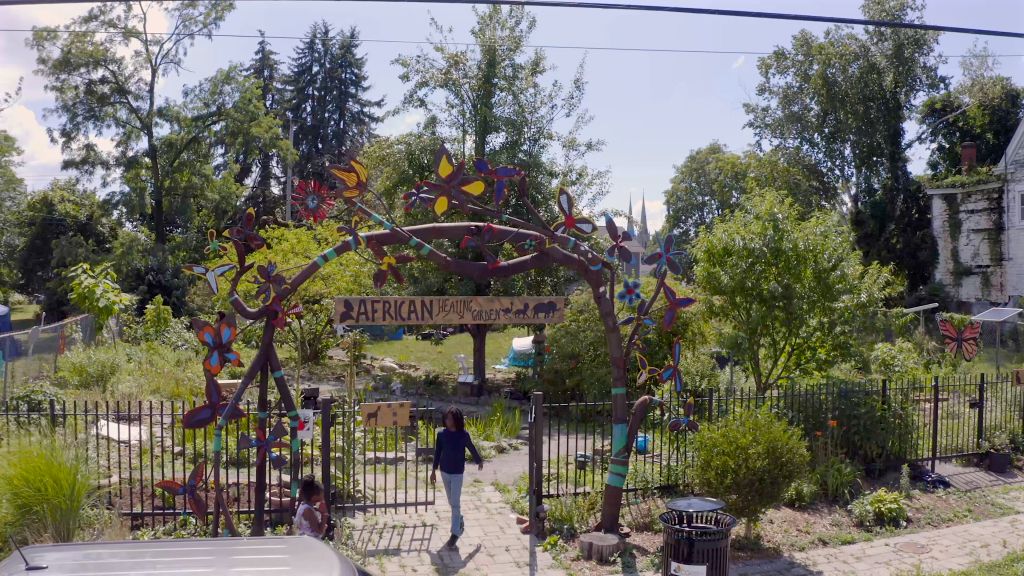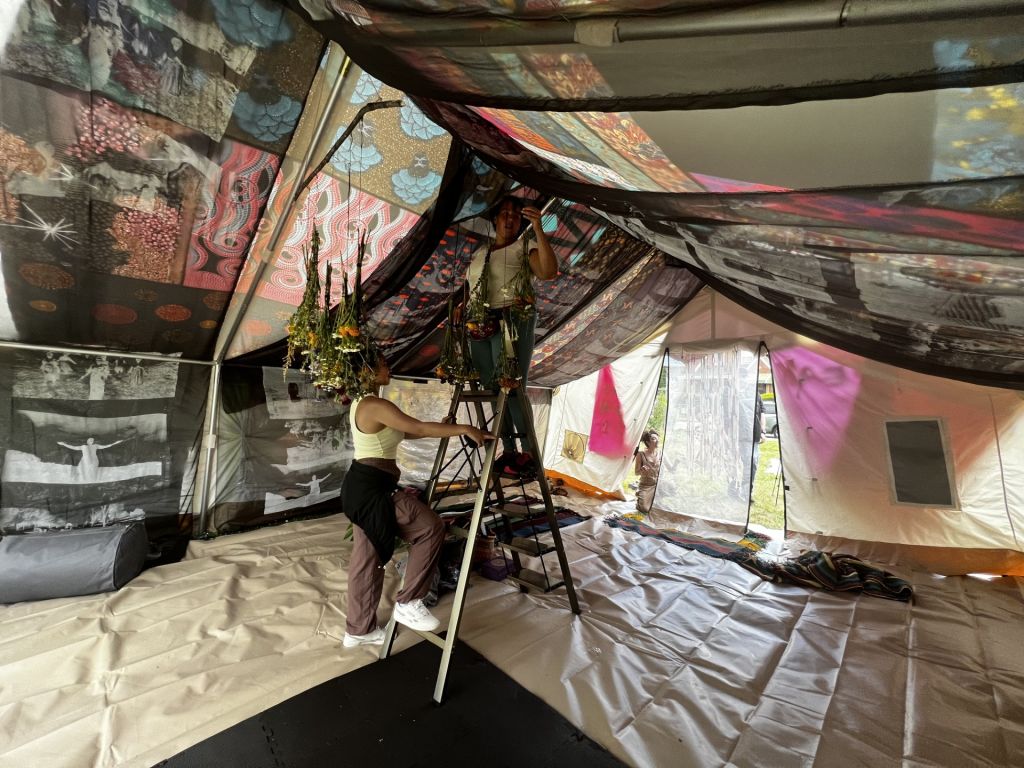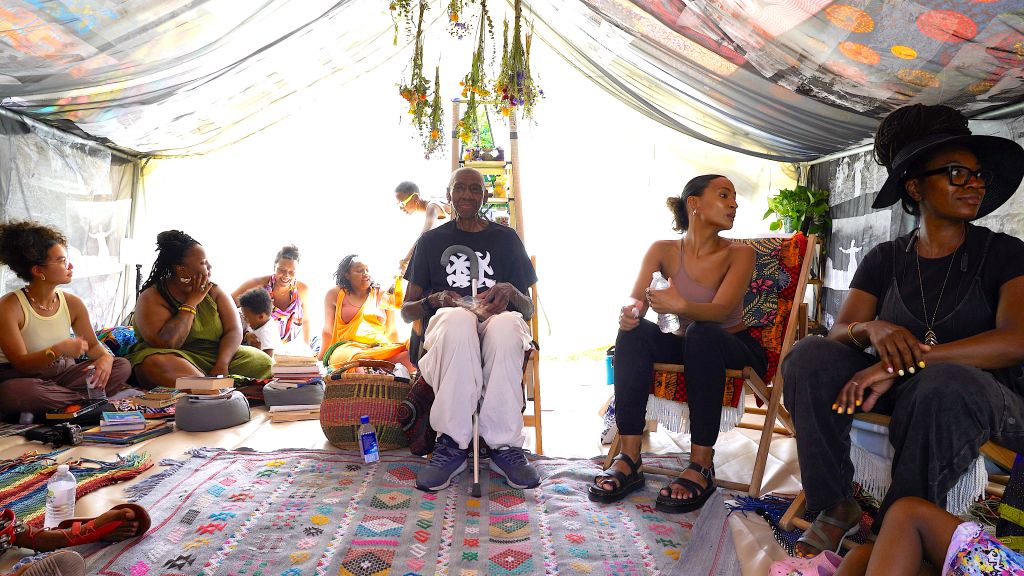Interdisciplinary Artist Alisha B. Wormsley Breaks Down Matriarchal Survival Strategies, Decolonizing Time And Her New Film

Source: iOne Digital Creative Services / iOne Digital Creative Services
The artist Alisha B. Wormsley tells stories of reclamation and rematriation; stories of a resurgent Black matriarchy locked in eternal conflict with capitalism, white supremacy, and patriarchy; stories that function as both historical and futuristic, parable and fact.
The container for these stories – which seem to be forever expanding, accelerating, and spinning themselves into new forms, like the universe itself – is a physical and theoretical archive called the Children of NAN.
NewsOne Presents Still Blooming In The Whirlwind: Pittsburgh As A Black Cultural And Artistic Mecca
Trained as an anthropologist, Wormsley is both the creator and the collector of the materials that comprise this database. The newest aspect of the archive is a forthcoming film entitled Children of NAN: a Survival Guide. Wormsley, the recipient of a 2022 Guggenheim Fellowship, is traveling the country, documenting the stories, lessons, and strategies of “matriarchal/femme activists, hood witches, healers, makers, and liberators” including Betty Lane, Lakeesha Harris, Tsedaye Makonnen, Mama Sadio and Ellen Sabastian Chang.
I’m really trying to make people feel cared for enough so that they can imagine, and they can dream.

Alisha B. Wormsley and her child Shepherd. | Source: Alisha B. Wormsley
You’ve been working on the Children of NAN archive for decades. There’s a mythology; there are objects; there are films; there are performances and rituals. And now you’re working on a documentary aspect, which involves visiting Black/Indigenous femmes and filming their stories and survival strategies. What inspired you to take the project in this direction?
There is a mythology, but it’s like an inter-dimensional truth. It’s the expansion of time. Past, present, and future all happening simultaneously. What happens in this Children of NAN dimension follows along the storyline of white supremacy, historical narrative, patriarchy, and the attack on matriarchy. What happens in reality happens in Children of NAN. These narratives are more like parables than mythology. It’s all about survival, care, and rematriation, so it’s a natural step for me to honor the survival strategies. I’m honoring the truth of Black matriarchy.
Can you talk a bit about the mobile sets you’ve created for this project, and how you’ll be using them?
The Temple of our Survival, the mobile film set (or altar), is a 16 x 20 foot tent quilted on the outside with African and African American quilting language and text. The inside is draped with hand printed textiles, handwoven rugs, tapestries, plant medicine, hanging plants, drying herbs, imagery of my ancestors and past video work of Black matriarchy. It also includes a library on Black femme survival, ancestor altars, a footbath, a typewriter, a loom, and crafts for quilting and weaving circles. All that I have made, grown, and collected. There is an area dedicated to rest, a table and chairs for spades, breaking bread and preparing. Another section is dedicated to meditation and apothecary and includes an area to read and write with a small library.
I’ve been weaving all of the rugs. Everything is designed based on African American quilting patterns. So just touching on African American spiritual symbols, dreaming symbols. There will be a projector, with a projection screen that I’ve quilted. I have a solar-powered generator so I can play projections and sounds. There are records.
It’s this rematriation, this Black matriarchy, that I’ve been obsessed with my whole life.
I have an apothecary filled with herbs. There’s a drying herb rack on top. So, wherever I am, I’ll be ethically foraging herbs to dry within the space. There’s a library. There are crafting materials for other people to craft. There are hammocks that I’ve woven. Everything is handmade by me or people that I’m connected with. I’m going to do a couple of community workshops where we’ll make things that will go into the altar.

Melike Konur, Sibyls Shrine current artist in residence, and son. | Source: Gaynelle Moss
I’m always curious, with a project of this scope and duration, how the various parts speak to each other. Do you look at it holistically and ask yourself what pieces are still missing? Is the story the guiding force? Or is it more that the archive is a vessel large enough to hold everything you want to do, and it’s not all necessarily connected in discrete ways?
I really love that. That is very true. The archive is me. I have the capacity to hold as much as I want, and I’m picking a specific aspect of the archive to work with. This film’s going to be 90 to 100 minutes, and we’re talking about generations, thousands of years of survival.
The film is going to be a component of the archive. Think of a database, and I type in survival. It’s survival I’m connected to and people. I’ve witnessed their survival. I’ve witnessed the generosity of their survival because it has affected so many other people, and I am trying to repeat that kind of ricochet. The archive in itself is to create a resonance for matriarchy, for a resurgence of Black matriarchy. That is my purpose on this planet as a maker, as a creator.
I’m going to do the best I can to make this film and honor the people in the film, but this is just a beginning. I would love for this to extend to a whole database of Black women surviving. I could go to every city, to every street, to every home where a Black woman is living, and ask them about survival. They will be able to tell me very clearly how they’re surviving, and what strategies they use. I started an arts residency for Black artists who mother [in Pittsburgh] called Sybil’s Shrine. We meet every Sunday, and each week someone is bringing in a survival strategy.
The term “archive” suggests an accumulation of materials – historical, weighty, meticulously cataloged, searchable, occupying some physical space. Can you talk about the idea of an archive? Was Children of NAN always an archive, or did it become an archive?
I studied anthropology in school. I was very inspired by Zora Neale Hurston, who’s also an anthropologist, [and] by the fluidity in which she could move and communicate with her communities and speak to them in a way that was not static and limited. Social sciences create these limitations. It’s white supremacy. It’s patriarchy. Even the information that they can receive, it’s limited by their own perspective. The way Children of NAN started was I had this idea about Black women and white men being at odds with each other, and a good collaborator of mine was telling me, “Oh, I think Black women and white men are like the zeros and ones in computer language.”

The front of The African Healing Garden, founded and stewarded by Matriarch Betty Lane. | Source: LKF ENT Films and Alisha B. Wormsley
I’m honoring the truth of Black matriarchy.
And so, I was like, what if they’ve always been at war? What if this white man is the child of this Black woman, and he is mad at her about something, and they’ve always been at war? And this is human life.
As long as there have been white people, they’ve been at war. And so, I started making this weird film about this apocalyptic future where the only people left on the planet are Black women and white men, and they’re at war. There’s no procreation. There are no new humans being made. So, the white men kidnap a Black woman, one of the fiercest warriors. Her name is NAN, and they extract her eggs before she escapes and make these children, the Children of NAN—and they’re these biracial women who also can’t procreate.
I was trying to make this film out of images I’d already taken from other projects. I have all these ideas and I do these shoots, and I film these things, and I just have these hard drives. And I made this really awesome eight-minute film. And I was like, oh my God. I could make a 12-hour film with all the things I have — all the things I’ve collected — because of my training in anthropology, of collecting things, of archiving them.
NAN is the most-used syllable for mother in African dialects, and so every Black woman is the child of NAN. And once I made that short film, I started to think about all the things I had been collecting and how they all connect. How does all of my work connect? And it’s this rematriation, this Black matriarchy, that I’ve been obsessed with my whole life.
The question you asked before, about what’s missing: When I would sit in church, I’d be like, What’s missing? Oh, the fact that Black women do everything for my community, and this religion is only talking about men. What did women, especially Black women, do to be treated this way? And then I realized, That’s a main tool of white supremacy. And so I have to counter that with my work. And then that’s how the archive came about.
The thing that’s different about my archive is that it can be edited, it can be changed. I’m constantly learning things. It’s constantly growing and adapting. It’s like Octavia Butler’s Parable of the Sower [says]: “God is Change.”

Alisha B. Wormsley and Chantal Feitosa Desouza installing The Temple of Our Survival. | Source: Alisha B. Wormsley
You’ve talked about your work existing in the past, present, and future at the same time, and of the need to reconsider our relationship to time – perhaps decolonialize that relationship. How does the Children of NAN archive accomplish this?
Expanding time is a way to decolonize. Look at Black Quantum Futurism, how they talk about time being used as a tool of oppression. The length of time that it takes to fight an eviction is longer than the time it takes for someone to evict you. That is a manipulation of time to oppress. And by expanding time, by understanding time is just a tool, you can decolonize.
Storytelling seems to be at the heart of the Children of NAN archive – and I mean a very concrete kind of narrative storytelling, not, “all art tells a story.” But more like “this could be an Octavia Butler novel.” I’m curious about the relationship between that strong narrative drive and some of the more abstract work that is also contained within the archive. And does that framing, narrative vs. abstract, even make sense to you?
I think it’s just the way you perceive it. I am really playing with these influences, like Octavia Butler, my grandparents, the way they told me stories, the way oral traditions are passed on. What I’m saying about breaking open time – it’s the same thing with the narrative. I can tell a story that’s so out there that it’s just like sci-fi. This is what Octavia Butler did, too. [The] original Children of NAN film is about Black women versus white men, and this is some apocalyptic future. But that’s really the present. It’s really been the history. I can tell it in a way that makes it so mystical, but I can also just show you by putting up two opposing images. I can tell you that same story. And maybe you don’t pull that same story from those two images, but that’s what I meant.

Mama Betty Lane is shown surrounded by Sibyls Shrine members in the Temple of Our Survival installed in the African Healing Garden, in the Larimer neighborhood of Pittsburgh, Pennsylvania. | Source: Alisha B. Wormsley / Alisha B. Wormsley
It’s a rare thing for an artist to birth a phrase that becomes a movement, as you did with “There Are Black People In The Future.” What about that experience has been the most surprising?
There Are Black People In the Future was just kind of a sci-fi Black nerd joke to me. It came out of a conversation I had with my partner, and I knew it was a good line. I was like, “Okay, this can be a part of the Children of Nan archive. Because I love sci-fi. I love the future. I’m a futurist.” But also, There Are Black People In the Future is this spell. It’s a ritual. I’m ensuring the future. It’s magic in a sense, or prayer. The same thing, essentially, to me.
Vibes today c/o Alisha B. Wormsley.
Image description: A sign that says there are Black people in the future. pic.twitter.com/Uki5PWW40p
— Naj (@najjmahal) September 25, 2020
What surprised me the most is that it really reflected how reactionary Black people have to be—how reactionary people who are constantly, consistently oppressed have to be. And how they can’t even really imagine that There Are Black People In the Future. The imagination of people has been so limited by capitalism, by white supremacy.
The archive in itself is to create a resonance for matriarchy, for a resurgence of Black matriarchy.
So even Black people don’t understand that sentence all the time. A friend told me how their middle school kid said, “That’s, of course. Duh.” People have said it’s ambivalent. There are all these things that they’re saying about it, when it’s really just asking you to imagine what an existence in the future could be.
And if you take away people’s imagination, you put them in a situation where they’re just trying to survive all the time. One thing I’m really trying to do with this rematriation and matriarchy is make people feel cared for enough so that they can imagine, and they can dream.
Adam Mansbach is a novelist, filmmaker (Barry), and writer whose work has appeared in The New Yorker, The New York Times Book Review, Esquire, The Washington Post and The Guardian. The Golem of Brooklyn is his latest book.
SEE ALSO:
Bonita Lee Penn Seeks To Connect Her History, Culture And Beliefs To Who She Is Today
Singer INEZ Wants To Build Pittsburgh’s Sprawling Black Music Scene Into A Unified Whole
window.addEventListener(‘interaction’, function () {
setTimeout(function () {
var s = document.createElement(‘script’), el = document.getElementsByTagName(‘script’)[ 0 ];
s.async = true;
s.src=”https://platform.twitter.com/widgets.js”;
el.parentNode.insertBefore(s, el);
}, 1000)
});
The post Interdisciplinary Artist Alisha B. Wormsley Breaks Down Matriarchal Survival Strategies, Decolonizing Time And Her New Film appeared first on NewsOne.





